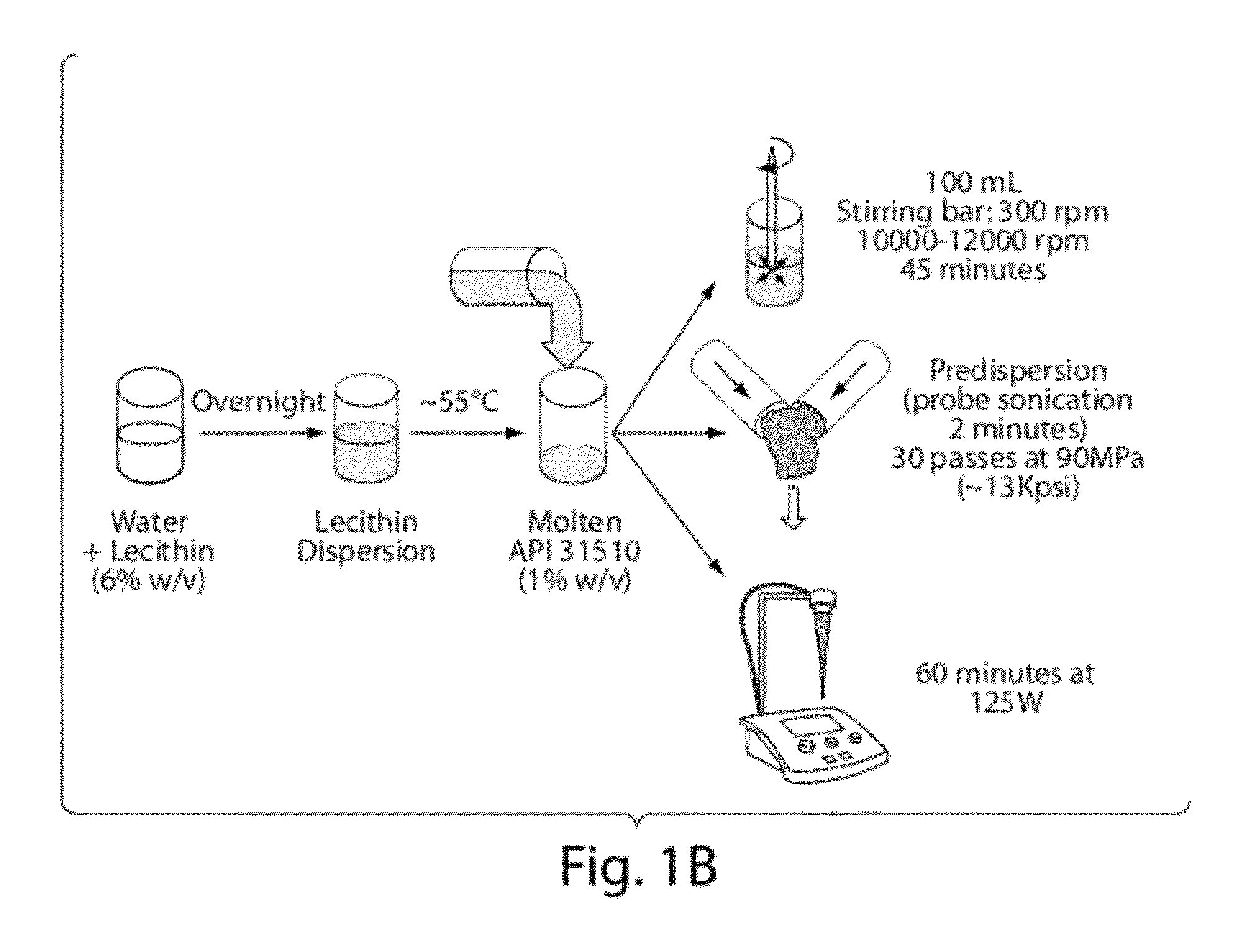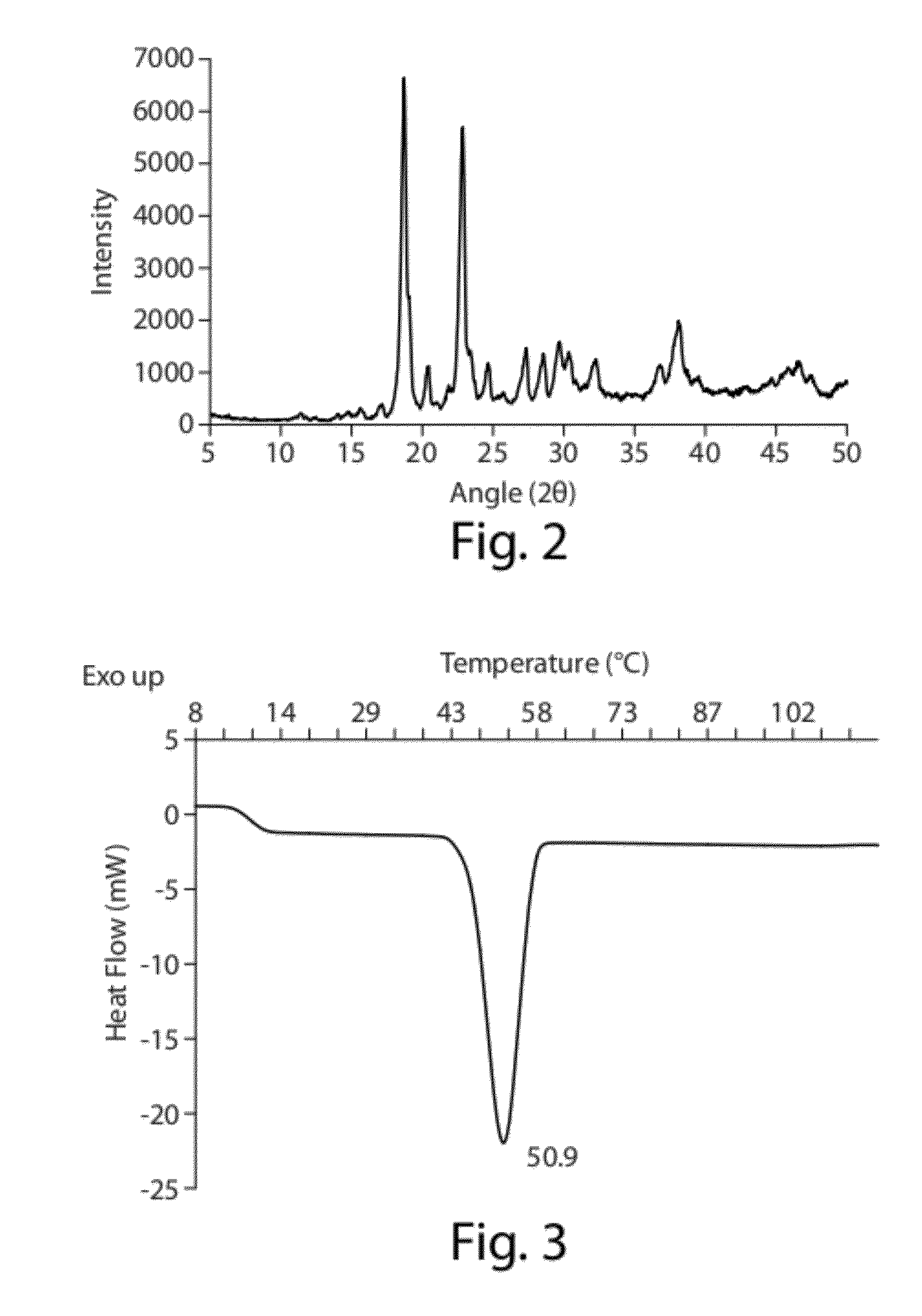Inhalable pharmaceutical compositions
a technology of pharmaceutical compositions and inhalable liquids, which is applied in the direction of aerosol delivery, antibacterial agents, dispersed delivery, etc., can solve the problems of traumatic injury to healthy tissue, nausea, secondary tumorigenesis, and many undesirable side effects, so as to avoid fogging of the lens
- Summary
- Abstract
- Description
- Claims
- Application Information
AI Technical Summary
Benefits of technology
Problems solved by technology
Method used
Image
Examples
example 1
Development and Characterization of Phospholipid-Stabilized Submicron Aqueous Dispersions of CoQ10 Adapted for Continuous Nebulization
[0172]This example provides methods for developing suitable formulations for pulmonary delivery of hydrophobic drugs using CoQ10 as a case study. Excipients (e.g., phospholipids) and an aerosolization device (e.g., Aeroneb Pro® vibrating-mesh nebulizer) were selected after an initial study (data not shown). Initial characterization of the bulk drug using X-ray diffraction (XRD), Differential Scanning calorimetry (DSC), Laser Diffractometry (LD) and Scanning Electron Microscopy (SEM) was performed. High shear mixing, high pressure homogenization or ultrasonication was then evaluated as feasible manufacturing processes to obtain small particle size dispersions of CoQ10. Following selection of an appropriate process, parameters affecting drug particle size were studied. Using LD and gravimetrical analysis, nebulization was evaluated to assess the perform...
example 2
Prediction of In Vitro Aerosolization Profiles Based on Rheological Behaviors of Aqueous Dispersions of CoQ10
[0233]Aerosolization of dispersed formulations can generate droplets containing variable drug concentration due to the heterogeneous nature of the dosage form. Therefore, it can be important to characterize formulations for in vitro drug deposition, which can be performed with cascade impactors. Laser diffractometry (LD) can also be used for this purpose, but LD's usefulness is generally limited to solution dosage forms. The nonhomogeneity of dispersions create droplets with heterogeneous concentrations of drug particles, rendering LD unsuitable. The United States Pharmacopoeia (USP) recommends the Next Generation Impactor (NGI) be used for this testing.
[0234]Human alveolar surfactant includes about 90% phospholipids and 10% neutral lipids. Among the phospholipids, phosphatidylcholine (PC) is predominant (76%), with DPPC being the main component (81% of PC) and dimyristoyl ph...
example 3
Pulmonary Deposition and Systemic Distribution in Mice of Inhalable Formulations of CoQ10
[0294]Example 3 presents an evaluation of in vivo systemic distribution, lung, and nasal depositions in mice following pulmonary delivery of CoQ10 formulations prepared with synthetic phospholipids. Three synthetic phospholipids were selected to stabilize these dispersions based upon the experimental results presented above and because of the phospholipids physiological occurrence in the lungs: DMPC, DPPC, and DSPC. Lecithin was not selected as a results of its low in vitro deposition. The dosing apparatus includes a nose-only inhalation chamber receiving aerosol generated by an Aeroneb Pro® vibrating-mesh nebulizer. The results showed the achievement of a high and sustained dose of CoQ10 to the mice's lungs, which varied from 1.8 to 3.0% of the theoretical exposure.
[0295]Materials and Methods
[0296]Materials:
[0297]CoQ10 was supplied by Asahi Kasei Corp. (Tokyo, Japan). Genzyme Pharmaceuticals (L...
PUM
| Property | Measurement | Unit |
|---|---|---|
| Temperature | aaaaa | aaaaa |
| Length | aaaaa | aaaaa |
| Length | aaaaa | aaaaa |
Abstract
Description
Claims
Application Information
 Login to View More
Login to View More - R&D
- Intellectual Property
- Life Sciences
- Materials
- Tech Scout
- Unparalleled Data Quality
- Higher Quality Content
- 60% Fewer Hallucinations
Browse by: Latest US Patents, China's latest patents, Technical Efficacy Thesaurus, Application Domain, Technology Topic, Popular Technical Reports.
© 2025 PatSnap. All rights reserved.Legal|Privacy policy|Modern Slavery Act Transparency Statement|Sitemap|About US| Contact US: help@patsnap.com



